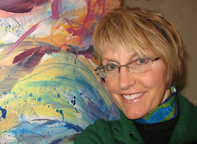In 2015, the SCC is celebrating its 40th anniversary. In 1975, fifty-seven Saskatchewan artisans organized themselves into a determined force with a single voice and a common purpose. That purpose was to promote and raise the profile of Saskatchewan artisans, improve the quality of work produced, and facilitate communication among the membership. Each of these people donated just $5 to this cause and the Saskatchewan Craft Council was born. You can read more about our history here.
Our board members and staff have come together to conduct interviews with as many of these founding members as we can, in celebration of this milestone. We are interested in these founders’ thoughts around why we came into being and their insights for the future.
Sharon Pulvermacher
 Sharon Pulvermacher was born in Bruno, Saskatchewan. She has a B.FA. (Honours) in ceramics, and a B.Ed. with distinction from the University of Saskatchewan. Sharon currently practices mixed-media art and watercolour painting, mostly focusing on Canadian landscapes, but began her artistic career as a professional potter. Sharon now resides with her husband, Bernard Laplante, in Regina, SK.
Sharon Pulvermacher was born in Bruno, Saskatchewan. She has a B.FA. (Honours) in ceramics, and a B.Ed. with distinction from the University of Saskatchewan. Sharon currently practices mixed-media art and watercolour painting, mostly focusing on Canadian landscapes, but began her artistic career as a professional potter. Sharon now resides with her husband, Bernard Laplante, in Regina, SK.
What compelled you to throw your $5 and yourself into creating a new organization dedicated to supporting craft?
I was a student at the University of Saskatchewan, finishing my BFA in pottery with Jim Thornsbury, when the call went out to form this new organization. It was an exciting time; we were in the midst of a back to the land movement. There were craftspeople like Gilhooly, Levine and Fafard turning art on its head and anything felt possible. Steep Hill Food Co-op was also formed around that time, so the cooperative tradition was familiar territory. I felt it was important to take craft seriously. It was a way of honouring what we made and how we made it. I grew up on a farm where we raised our own food, made our own clothes, and were proud to do so. To create something that someone would buy and use in their daily life seemed very fine, indeed. But we needed an organization to help move our crafts to this next level. Around that time, I traveled to Quebec and noticed how they really appreciated their craftspeople. Creating something of beauty with a long tradition behind it was integral to the culture. When sporting groups held a fundraiser, the raffle prize was handmade art or craft instead of a Texas Mickey. I found we in Saskatchewan took our craft artists for granted and that needed to change.
What are you most proud of over the last 40 years?
I am proud of the support and visibility the Craft Council has given to craftspeople like Lee Brady, Ken Wilkinson, and Anita Rocamora, for example, who have national and international recognition partly because of the framework and community support that the Craft Council has provided.
What has disappointed you?
These days, we seem to have a disconnect from the land in all our sourcing; be it food, clothing, or other goods. There are fewer stories available about where the objects in our lives come from. Works of art raise our consciousness of the beauty and richness of the world around us. We are becoming a throwaway society, with questionable ethics around procuring from the cheapest source. Our youth are not readily exposed to beautiful, handmade objects and there is a danger of losing a certain sensibility and appreciation of the world of fine crafts.
What are your hopes for the future?
We are beyond the tipping point of how we humans live within the natural world. Perhaps craft can be a mediator of a renewed connection with the Earth. I hope our children’s children learn to create with the elements of Mother Earth, to release their own unique and functional expressions of possibility, wonder and creativity. I hope they give voice to the rich tradition of craft, to strengthen a sense of authenticity and reciprocity with the Earth, incorporating the old with the new to re-imagine how to live well on this planet. A tall order!
What are you doing to celebrate Craft Year 2015 and our 40th anniversary?
It would be a treat to reconnect with my former professor, Jim Thornsbury. I will certainly continue my creative explorations. Maybe I’ll invest in forty beautifully crafted Saskatchewan objects d’art. That would be sweet, too!
